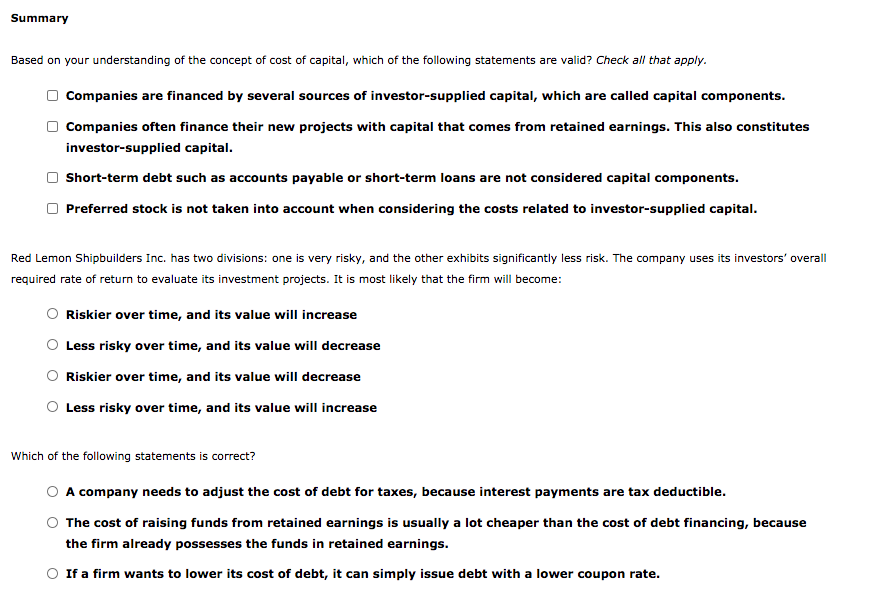Answered step by step
Verified Expert Solution
Question
1 Approved Answer
1. Factors affecting a firm's weighted cost of capital THE IMPORTANCE OF KNOWING A FIRM'S COST OF CAPITAL Cost of capital In 2010 the Federal


1. Factors affecting a firm's weighted cost of capital THE IMPORTANCE OF KNOWING A FIRM'S COST OF CAPITAL Cost of capital In 2010 the Federal Reserve Board (the Fed) reported that nonfinancial companies in the United States had around $2 trillion in cash and short-term liquid assets. As the U.S. economy was still struggling, consumer spending remained low, and companies resisted in investing in new projects that would create value for their stakeholders. As the economy improves, uncertainty in the markets decreases, and companies will start investing in projects. However, the challenge of analyzing and selecting projects that would generate cash flows and returns and add value to the firm would remain. The assumptions in the analysis about cost of equity and debt-overall and for projects-have a significant impact on the type and the value of investments that a company makes. According to the Association of Finance Professionals' report, published in 2011 on current trends in estimating and applying the cost of capital, companies use a discount rate that is usually above or below 1% of the company's true rate. Using this information and certain inputs from the Fed, Michael Jacobs and Anil Shivdasani estimated that a 1% drop in the cost of capital leads U.S. companies to increase their investment by about $150 million over three years. Source: Michael T. Jacobs and Anil Shivdasani, "Do You Know Your Cost of Capital?" Harvard Business Review, http://hbr.org/2012/07/do-you-know-your-cost-of- capital/ar/1. Summary Based on your understanding of the concept of cost of capital, which of the following statements are valid? Check all that apply. Companies are financed by several sources of investor-supplied capital, which are called capital components. Companies often finance their new projects with capital that comes from retained earnings. This also constitutes investor-supplied capital. Short-term debt such as accounts payable or short-term loans are not considered capital components. Preferred stock is not taken into account when considering the costs related to investor-supplied capital. Red Lemon Shipbuilders Inc. has two divisions: one is very risky, and the other exhibits significantly less risk. The company uses its investors' overall required rate of return to evaluate its investment projects. It is most likely that the firm will become: Riskier over time, and its value will increase Less risky over time, and its value will decrease Riskier over time, and its value will decrease o Less risky over time, and its value will increase Which of the following statements is correct? A company needs to adjust the cost of debt for taxes, because interest payments are tax deductible. The cost of raising funds from retained earnings is usually a lot cheaper than the cost of debt financing, because the firm already possesses the funds in retained earnings. If a firm wants to lower its cost of debt, it can simply issue debt with a lower coupon rate
Step by Step Solution
There are 3 Steps involved in it
Step: 1

Get Instant Access to Expert-Tailored Solutions
See step-by-step solutions with expert insights and AI powered tools for academic success
Step: 2

Step: 3

Ace Your Homework with AI
Get the answers you need in no time with our AI-driven, step-by-step assistance
Get Started


